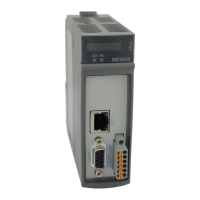6. REDUNDANCY WITH NX3030 CPU
6.4.12. POUs from the Program Type with Redundant Symbolic Variables
The user can declare redundant symbolic variables in POUs from the program type, with exception of the NonSkippedPrg
POU where the symbolic variables declared are considered redundant.
In order to define a new POU as redundant, it must be marked in the Redundancy Configuration object after its creation, in
the project devices tree. By default, all POUs created by the user are, initially, redundant.
ATTENTION
For good practice it’s recommended to avoid the AT directive use in POUs which have re-
dundant symbolic variables declaration to prevent variable mapping in non-redundant areas.
6.4.13. Breakpoints Utilization in Redundant Systems
For redundant systems it’s recommended to use breakpoints only in the Active half-cluster, with the other half-cluster
deactivated. If not, when the application execution reaches a breakpoint, the Stand-by breakpoint will take over the Active
state, switching off the Active PLC.
6.4.14. MODBUS Instances Managing in Redundant System
In case the vital fault of the Ethernet interfaces is disabled or in the case of MODBUS instances Server, MODBUS in-
stances are independent of redundancy and, therefore, must be managed in the application, being at the user’s discretion which
instances should be enabled/disabled when a PLC enters a Non-Active state. When the vital fault is enabled for Ethernet ports
with MODBUS Client, it is not necessary to implement additional code to control the switch-over.
The example below, inserted in a NonSkippedPrg program, executes the verification of the PLC current state and in case
it’s in Non-Active state, disables the MODBUS RTU master and slave instances and the MODBUS Ethernet Server instance:
VAR
eRedStateLocal : REDUNDANCY_STATE;
eRedStateLocal_old : REDUNDANCY_STATE;
END_VAR
// Local PLC current state reading
eRedStateLocal := DG_NX4010.tRedundancy.RedDgnLoc.sGeneral_Diag.eRedState;
// Has the local PLC state changed?
IF eRedStateLocal <> eRedStateLocal_old THEN
IF eRedStateLocal = REDUNDANCY_STATE.ACTIVE THEN
// The local PLC has entered the Active state
Diagnostics.DG_MODBUS_RTU_Slave.tCommand.bRestart := TRUE;
Diagnostics.DG_MODBUS_RTU_Master.tCommand.bRestart := TRUE;
Diagnostics.DG_MODBUS_Server.tCommand.bRestart := TRUE;
ELSE
// The local PLC has entered the Non-Active state
Diagnostics.DG_MODBUS_RTU_Slave.tCommand.bStop := TRUE;
Diagnostics.DG_MODBUS_RTU_Master.tCommand.bStop := TRUE;
Diagnostics.DG_MODBUS_Server.tCommand.bStop := TRUE;
END_IF
// Saves the last state of the local PLC
eRedStateLocal_old:= eRedStateLocal;
END_IF
316

